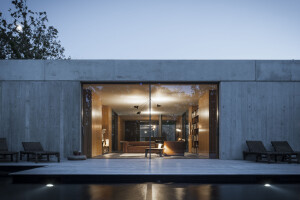The White Lady
Widely known as “The White Lady on Kongens Nytorv”, the more than 250-year-old Hotel d’Angleterre is an icon and a historic landmark in Copenhagen. Celebrated for its elegance, luxury and style, for centuries the hotel has provided accommodation fit for kings and princes and, more recently, rock bands and movie stars too.
When C.F. Møller Architects first looked at the existing conditions, we realised that continuously changing requirements had affected the overall appearance of the hotel, inside and outside: Walls had been pulled down, concrete decks had been erected and ceilings lowered to provide space for ventilation. The result was an impaired spatial impression.
The hotel has undergone a complete refurbishment, which is inspired by its rich heritage. It has now reopened as a revitalised grand palace. The goal has been not only to design a modern and functional flow, but also to provide a new spatiality to the public areas and rooms.
The new style of the hotel is contemporary classic. There are elegant materials in light and pleasant tones, exclusive surfaces and subdued decorative effects, which clearly emphasise the connection between the new and the old, and beautifully accentuate a plethora of outstanding rooms within its walls. Balancing elegance with a feeling of being at home, the renovation substantiates the white lady’s proud traditions.
The new Hotel d’Angleterre
Façades
To re-establish the spirit of a grand palace, the façades facing Kongens Nytorv, Hovedvagtsgade, Østergade and Ny Østergade were renovated to reinvent the Parisian look. This was achieved by changing the colour of the façade from creamy white to a sophisticated grey white and by replacing the old, white, low-cost windows with new, dark-green windows, which create a tasteful contrast to the white façade.
At ground floor level, the hotel opens up towards the city with magnificent large windows. The impressive light steel window frames have been specially designed for the hotel and they revitalize the façade, giving it an air of modern elegance.
The windows create splendid new views of the Copenhagen skyline and the outdoor lighting fosters a pleasant, appealing atmosphere.
New white awnings add a touch of poetry to the old building, while clearly signalling that the hotel has been restored.
Balconies and balustrades as well as ornaments and figurines have been cleaned and painted. Roofs, chimneys, all details of the railings and the antique lamps have also been restored to their former glory.
A cartouche with the royal coat of arms of the United Kingdom has been reconstructed and now crowns the façade.
Courtyard
The rooms and suites facing the inner courtyard overlook the glass roof of the Palm Court below. The facades in the courtyard have been totally renovated in the same elegant style as the facades facing Kongens Nytorv. The walls are classy grey-white and the dark-green windows extend from floor to ceiling.
All rooms and suites have private balconies with sleek black steel sections that give the balconies a light and floating expression and ensure generous daylight conditions in the rooms. The modern balconies have a few subtle details which match the distinctive expression of the hotel: small, decorative spheres and fleurs-de-lis.
Main entrance
The main entrance is fitted with fully insulated double-glazed windows on a very large scale, bringing natural light deep into the building. The windows allow passers-by to catch a glimpse of the ambiance inside the building, while giving the guests a view of vibrant urban life right outside the hotel.
In the entrance area a low ceiling has been removed to re-establish the original ceiling height and to make possible the insertion of new and very impressive tall doors.
The original ceiling in the hall with its exquisite rosettes has been painstakingly renovated.
Reception
By demolishing a mezzanine, the reception has regained its original proportions and now appears spacious and airy. Direct access from the public area (reception and lobby) to the elevators leading up to the more private areas of the hotel has been established. This optimises access for VIPs as well as for the disabled.
The reception area, which was previously a circumscribed space, has been opened up towards the exterior with large windows which let in the daylight.
Main stairs
An existing narrow staircase leading from the lower level to the first floor has been replaced by a new broad staircase fitted symmetrically around a central pillar. The new staircase provides a more functional flow and adds new grandeur to the central stairwell. The balustrades of the new staircase have been designed in harmony with the hotel’s contemporary classic appearance. A feature in the panel of the steel balustrades is inspired by an original railing discovered in the Palm Court during renovation. The new staircase leads up to the first floor where it meets the original, impressive, curved staircase leading to the upper floors.
The curved staircase has been renovated to give the stairwell an entirely new appearance. The dark wood has been painted in an elegant white colour and a claret-coloured carpet is replaced by a new pale grey carpet creating a beautiful contrast to the white balustrades.
When the old ceiling was torn down, an original rosette was revealed above the stairwell. This rosette has been restored and a chandelier is now suspended from it.
Corridors
To create a more intimate feel, the traditional long and monotonous corridors have been changed into rhythmic arcades. The arches create smaller, more private units in the corridors. At the same time, they resolve a technical challenge as technical installations are concealed in the arches and can be easily accessed for maintenance and upgrades. Pleasant low lighting underpins the cosy atmosphere.
New distinctive doors in smoked oak with fine detailing lead into the rooms and suites, and the suites in the wing facing Kongens Nytorv are all equipped with a butler’s cupboard as well.
Rooms & Suites
The main challenge when working with the refurbishment of the rooms and suites has been to strike a delicate balance between modern comfort and state-of-the-art technology on the one hand and remaining loyal to the hotel’s priceless brand and heritage on the other.
Rooms have been consolidated to accommodate guests’ wishes. The original total of 123 rooms is reduced to 90, and each one has been completely renovated. The new rooms are spacious and functional rooms that combine the four main functions of hotel accommodation: sleeping, bathing, dressing and relaxing. No two rooms are alike. Each is unique and yet kept within the same elegant palette of colours and hues.
The different types of rooms include:
Deluxe bedrooms and suites: Between 35 m2 and 65 m2 of modern grandeur
Themed suites: Approximately 95 m2, the interiors of which are inspired by historical Danish authors and artists, such as Karen Blixen, H. C. Andersen, Ludvig Holberg, Bertel Thorvaldsen and H. C. Lumbye.
The Royal Suite: Exquisitely decorated with refined elegance, the 150 m2 Royal Suite is lavishly furnished with gilded panelling, plush carpeting and grand chandeliers, which enhance its palatial atmosphere. The Royal Suite comprises a master bedroom with a grand en-suite bathroom, a stately living room, a private dining room and a spacious balcony with stunning views of Kongens Nytorv. Connecting doors provide the option to extend the Royal Suite with two additional bedrooms, to create a 250 m2 suite.
GA Design International has been involved in the layout of the rooms as well as the restaurant.
Private function rooms
The historical banqueting rooms and lounges have all been restored with respect for the original ambiance. The luxurious Palm Court ballroom has room for up to 400 guests. In conjunction with the adjacent Gallery and Louis XVI salons, it can accommodate up to 580 guests. Original balconies in the lofty ballroom were previously concealed behind inserted walls. They have now been reopened, lending even more style and dignity to this impressive room, which also features the largest glass mosaic roof in Europe.
Restaurant Marchal
In the dining area on the ground floor, the original ceiling height has been re-established. The restaurant opens up towards Kongens Nytorv with the new, impressively large windows creating a friendly space flooded with daylight.
Inside the dining area itself a suite of glass walls defines the separate areas: the hall, the bar, the tasting room and Restaurant Marchal farthest to the south. From the restaurant there is a view of the kitchen area where food is arranged.
Champagne Bar Balthazar
A low-ceilinged room previously housing Hotel d’Angleterre’s staff changing room has been converted into the new champagne bar, Balthazar. An inserted floor has been removed and new windows have been fitted from floor to ceiling facing Ny Østergade and Hovedvagtsgade. A new public entrance from Hovedvagtsgade has been created to open this bright and accommodating champagne bar to Copenhageners and the outside world.
SPACE Copenhagen created the interior design.
Hotel d’Angleterre and Copenhagen
The refurbishment of Hotel d’Angleterre has been a very exciting and also a very demanding architectural assignment. Established in 1755, Hotel d’Angleterre is an icon and an historic landmark in Copenhagen. It is one of the world’s oldest luxury hotels. Royal visitors and celebrities have stayed at the hotel for centuries.
The old hotel is one of the main attractions on one of the most famous squares in Copenhagen; Kongens Nytorv, also known as Krinsen (the wreath or circle) after the Baroque garden in the middle of the square, which dates from 1688. Adjacent to the Royal Theatre, Charlottenborg Palace, the French Embassy and Magasin du Nord, the hotel occupies one of the square's chief corners.
The hotel has been renovated and extensions built on numerous occasions since 1755. The current building was erected between 1873 and 1875 and is the work of a famous Danish architect, Vilhelm Dahlerup.After a fire in 1915 the hotel was rebuilt once again, this time by architects Philip Smidth and Nicolai Hansen.
The hotel has always had a signature, modern façade facing Kongens Nytorv. Originally, there was a delicate coherence between the interior and the exterior. In the course of time, the d'Angleterre gradually became enclosed and inward-facing. The hotel has been adapted to different periods in response to contemporary trends, technological advances and the demands of modern functionalism. Walls were torn down, ceilings inserted to contain technical installations, and concrete decks were erected to accommodate a growing administration.
As a result, the spatial perception of the interior and the façades facing the streets were compromised; the hotel seemed like a decadent old lady.
In June 2011 Hotel d’Angleterre was closed to guests and staff. It has been completely refurbished from cellar to attic to create a hotel which maintains the atmosphere of a luxurious private home - indeed, not surprisingly, a Danish home.
In May 2013 the rejuvenated grand palace re-opened following renovations that have preserved the historic building and given it a contemporary classic appearance.


























































